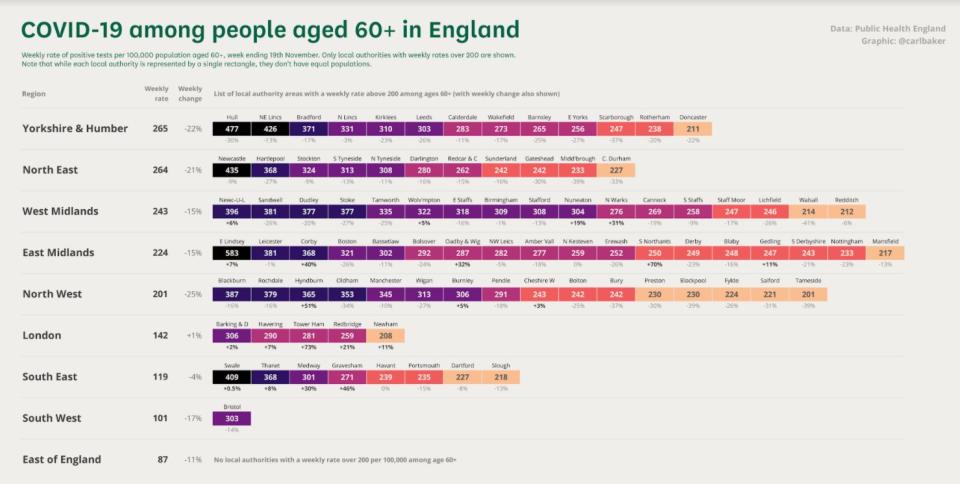Chart shows how many COVID-19 cases in over 60s are in your area
A new chart shows how many COVID-19 cases in over 60s are in different areas in England which is one of the five key metrics the government is using to determine lockdown tiers.
Boris Johnson has warned an increased number of regions will be put under “tougher” measures in a revised three-tier localised system when the national lockdown ends next Wednesday.
Many regions are expected to be placed in the higher second and third-tier when the list is published on Thursday.
The prime minister revealed the rate of infection among the over 60s was important in determining what tier areas were placed in.
Other factors include the coronavirus infection rate in all ages, if infections are rising or falling, the positivity rate (a measure to see if the testing system is coping) and how much pressure is being put on the NHS.
A graphic from Commons Library’s Carl Baker shows which regions and local authorities currently have the highest infections in over 60s.

The chart, which was formulated using data from Public Health England (PHE), revealed Yorkshire and Humber had the highest weekly rate at 265.
Next on the list was North East with 264, followed by West Midlands with 243 and East Midlands with 224.
North West fared a little better with a weekly rate of 201, London had 142 and South East 119.
The regions with the lowest weekly infection rates among over 60s in England were South West with 101 and East of England with 87.
The individual areas with the highest rate of infection for that age group were East Lindsey with 583, followed by Hull with 477 and Newcastle with 435.
Watch: How England's new three-tier COVID system will work
Under the revised three-tier system:
Pubs and restaurants face the toughest measures. In a change from the PM’s previous tier system, those in the strictest Tier 3 will only be allowed to offer takeaways, while pubs and restaurants in Tier 2 will only be able to sell alcohol with a substantial meal.
Indoor entertainment venues and hotels will have to close in Tier 3 areas.
Non-essential shops and gyms will be allowed to reopen across all three tiers, while the bans on outdoor grassroots sport and collective worship have also been lifted.
The “rule of six” – allowing social gatherings of up to six people – will apply outdoors across all tiers.
People in Tier 1 should work from home “wherever possible”.
The 10pm curfew has been changed to 11pm, with last orders now at 10pm and closing at 11pm.
In Tiers 1 and 2, spectator sports will be allowed to resume “with capacity limits” – though Johnson didn’t say what these would be
Watch: How to remove a face covering correctly
Coronavirus: what happened today
Click here to sign up to the latest news and information with our daily Catch-up newsletter

 Yahoo Movies
Yahoo Movies 
